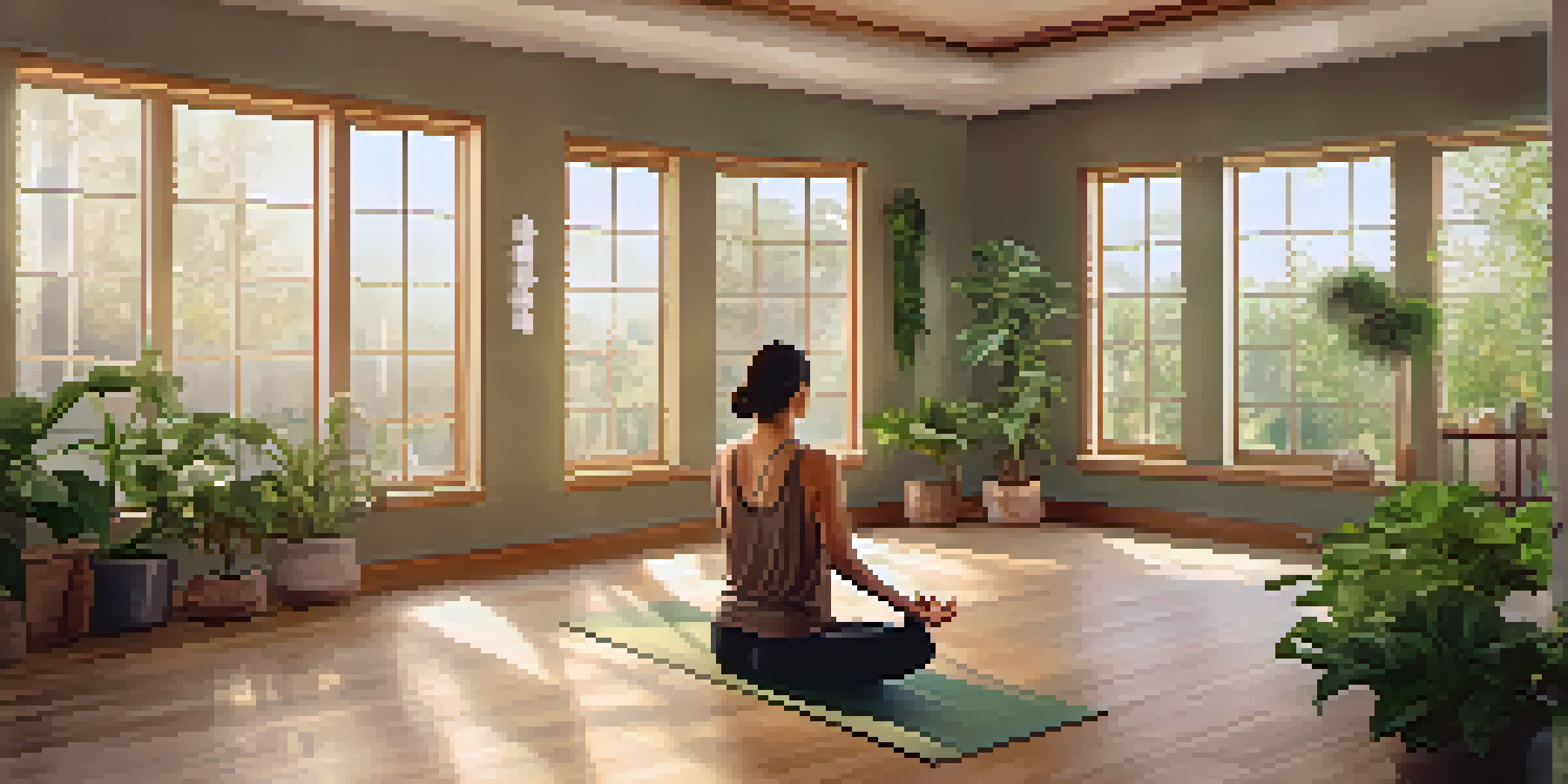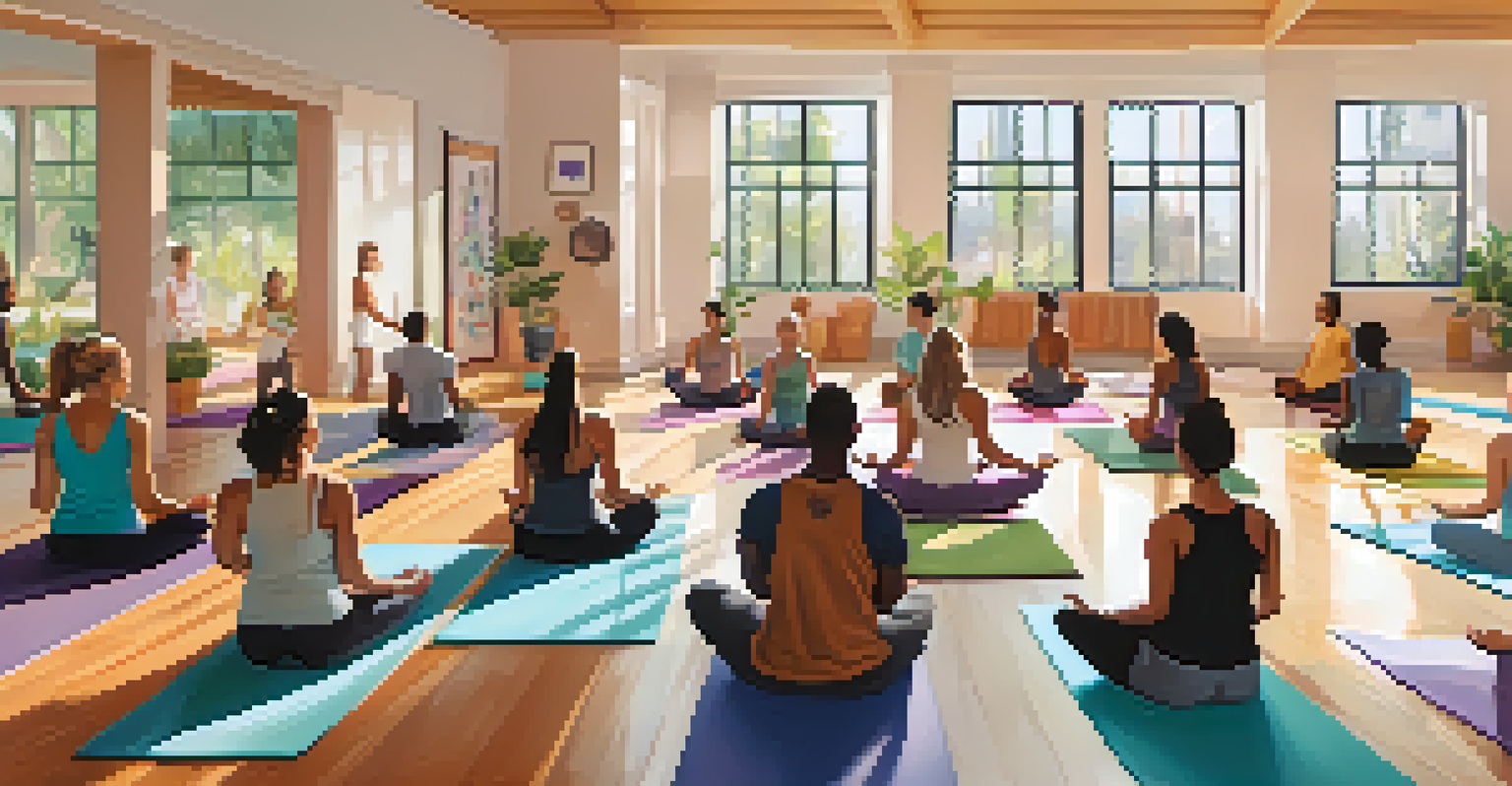The Benefits of Yoga for Seasonal Affective Disorder Relief

Understanding Seasonal Affective Disorder (SAD)
Seasonal Affective Disorder, commonly known as SAD, is a type of depression that typically occurs during the fall and winter months when daylight hours are shorter. Many people experience feelings of sadness, lethargy, and a lack of motivation during this time, which can significantly impact daily life. Understanding SAD is crucial, as it helps individuals recognize that they are not alone in their struggles and that effective relief options are available.
Yoga is the journey of the self, through the self, to the self.
The symptoms of SAD can vary from person to person but often include irritability, changes in sleep patterns, and difficulty concentrating. This condition is linked to changes in light exposure and can disrupt the body’s natural circadian rhythms. By acknowledging these symptoms, individuals can take proactive steps toward finding relief, leading to better mental health.
While traditional treatments like therapy and medication are effective for many, incorporating alternative methods, such as yoga, can provide additional support. Yoga not only offers physical benefits but also promotes emotional well-being, making it a holistic approach to combatting SAD.
How Yoga Promotes Emotional Well-Being
Yoga is much more than a physical practice; it’s a way to connect the mind and body. By focusing on breath and movement, yoga encourages mindfulness, which can help reduce anxiety and improve mood. This connection is especially beneficial for those struggling with the emotional toll of SAD, as it fosters a sense of calm and clarity.

Moreover, the practice of yoga encourages the release of endorphins, the body’s natural mood lifters. These feel-good hormones can help counteract feelings of sadness and lethargy that often accompany SAD. Regular yoga sessions can lead to improved mental resilience, making it easier to navigate the ups and downs of seasonal changes.
SAD Affects Mood in Winter Months
Seasonal Affective Disorder (SAD) leads to feelings of sadness and lethargy during fall and winter due to shorter daylight hours.
In addition to physical postures, many forms of yoga incorporate meditation and relaxation techniques. These practices can help quiet the mind, making space for positive thoughts and feelings, further enhancing emotional well-being during challenging months.
Physical Benefits of Yoga for SAD Relief
Engaging in regular physical activity is known to boost overall health, but yoga offers unique benefits that can be particularly helpful for those with SAD. The gentle movements can improve flexibility and strength, which may help combat the physical fatigue often felt during the winter months. Feeling physically stronger can contribute to a more positive self-image and increased motivation.
Inhale the future, exhale the past.
Additionally, yoga encourages better circulation and can help combat the sluggishness that comes with reduced sunlight exposure. Improved blood flow not only enhances physical health but also elevates mood, making it easier to tackle daily tasks and responsibilities. This increased energy can lead to a more active lifestyle, which is beneficial for mental health.
Moreover, practicing yoga can help regulate sleep patterns. Many people with SAD experience disruptions in their sleep, which can exacerbate feelings of depression. By incorporating yoga into a daily routine, individuals may find it easier to fall asleep and enjoy a more restful night, contributing to overall emotional resilience.
Building a Supportive Yoga Community
One of the most rewarding aspects of practicing yoga is the sense of community it fosters. Joining a local yoga class or an online group can provide support and encouragement, which is especially important for those dealing with SAD. Connecting with others who understand your struggles can create a safe space for sharing experiences and coping strategies.
In many yoga classes, participants often share their journeys, creating a network of support that can be incredibly uplifting. This camaraderie can help combat feelings of isolation associated with SAD, reminding individuals that they are not alone in their experiences. Having a supportive community can encourage regular practice and accountability.
Yoga Enhances Emotional Well-Being
Practicing yoga promotes mindfulness and releases endorphins, helping to counteract the emotional toll of SAD.
Furthermore, many yoga studios offer specialized classes focused on mental health and emotional well-being. These classes can provide tailored techniques and practices that specifically address the symptoms of SAD, making the journey toward relief more accessible and effective.
Finding the Right Yoga Style for You
With a variety of yoga styles available, it’s important to find one that resonates with your needs, especially when coping with SAD. Gentle practices like Hatha or Yin Yoga focus on slow movements and deep stretching, making them ideal for relaxation and stress relief. These styles can help ease tension and create a sense of calm.
On the flip side, if you're looking for something more energizing, Vinyasa or Ashtanga yoga may be more suitable. These styles incorporate flowing movements and can elevate your heart rate, helping to boost mood and energy levels. Experimenting with different types can help you discover what feels best for your mind and body.
Attending different classes or following online sessions can help you find your perfect match. Ultimately, the best yoga style for you is the one that you enjoy and feel motivated to practice regularly, as consistency is key in experiencing the benefits for SAD relief.
Incorporating Mindfulness into Your Yoga Practice
Mindfulness is a powerful tool for managing the symptoms of SAD, and yoga is an excellent way to cultivate this practice. By focusing on the present moment during your yoga sessions, you can learn to let go of negative thoughts and feelings that may arise. Mindfulness encourages awareness of your body and mind, helping you to recognize and address emotional triggers.
Incorporating mindfulness techniques, such as deep breathing and body scans, into your yoga routine can enhance the overall experience. These practices can help ground you, allowing for deeper relaxation and a greater sense of peace. Over time, this can lead to improved emotional regulation and resilience against the symptoms of SAD.
Community Supports Yoga Practice
Joining a yoga community provides encouragement and shared experiences, which can alleviate feelings of isolation related to SAD.
Additionally, mindfulness can extend beyond your yoga mat. By practicing mindful awareness throughout your day, you can develop healthier coping mechanisms for stress and depression, creating a more balanced emotional landscape, especially during challenging seasons.
Creating a Consistent Yoga Routine for SAD Relief
Establishing a consistent yoga routine can be a game changer in managing Seasonal Affective Disorder. Just like any other form of exercise, regular practice is essential for reaping the benefits. Setting aside dedicated time for yoga each week can help create a sense of stability and predictability, which is often comforting during times of emotional turbulence.
Start by setting realistic goals, such as committing to two to three sessions a week. Whether it’s a 15-minute online class or an hour-long studio session, consistency is more important than duration. As you begin to notice the positive effects on your mood and energy levels, you may find yourself naturally wanting to practice more often.

Lastly, remember that it’s okay to adapt your practice based on how you’re feeling. Some days you may crave a vigorous flow, while other days, restorative poses may be more appropriate. Listening to your body and being gentle with yourself is key to creating a sustainable and enjoyable yoga practice during the winter months.